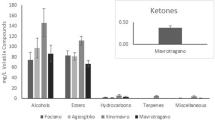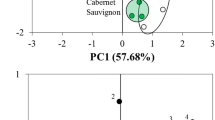Abstract
The present work intends to study, for the first time, the characterization of the phenolic composition (hydroxycinnamic and hydroxybenzoic acids derivatives, stilbenes, anthocyanins, and flavan-3-ols) of Montenegrin autochthonous varietal wines Vranac, Kratošija, and an international recognized variety, Cabernet Sauvignon, from different locations of Montenegro, under the same conditions and enological practices by applying chromatographic techniques. The studied varietal wines showed specific varietal profiles for the examined phenolic groups: relative proportion of hydroxycinnamic acids, composition of stilbenes, anthocyanin profile, flavan-3-ols composition of monomers and dimers, as well as some certain wine varietal ratios, namely acetylated/p-coumarylated anthocyanins and trans-coutaric/trans-caftaric acid. Principal component analyses confirmed a separation according to varietal wines. A linear discriminant analysis proved the discriminant power of the phenolic profile to authenticate wine varieties. Vranac wines contained the highest content of anthocyanins. Kratošija wines had the highest content of hydroxycinnamic acids. Cabernet Sauvignon wines contained the highest content of flavan-3-ols and the lowest content of stilbenes. All wines showed high antioxidant activity.


Similar content being viewed by others
References
Frankel EN, Waterhouse AL, Teissedre PL (1995) Principal phenolic phytochemicals in selected California wines and their antioxidant activity in inhibiting oxidation of human low-density lipoproteins. J Agric Food Chem 43:890–894
Monagas M, Suarez R, Gómez-Cordovés C, Bartolomé B (2005) Simultaneous determination of nonanthocyanin phenolic compounds in red wines by HPLCDAD/ESI-MS. Am J Enol Vitic 56:139–147
Cheynier V, Dueñas-Patron M, Souquet MJ, Sarni-Manchado P, Fulcrand H (2006) Structure and properties of wine pigments and tannins. Am J Enol Vitic 57:298–305
Mattivi F, Zulian C, Nicolini G, Valenti L (2002) Wine, biodiversity, technology, and antioxidants. Ann N Y Acad Sci 957:37–56
Gris EF, Mattivi F, Ferreira EA, Vrhovsek U, Pedrosa RC, Bordignon-Luiz MT (2011) Proanthocyanidin profile and antioxidant capacity of Brazilian Vitis vinifera red wines. Food Chem 44:2851–2860
Rigo A, Vianello F, Clementi G, Rossetto M, Scarpa M, Vrhovšek U, Mattivi F (2000) Contribution of proanthocyanidins to the peroxy radical scavenging capacity of some Italian red wines. J Agric Food Chem 48:1996–2002
Eder R, Wendelin S, Barna J (1994) Klassifizierung von Rotweinsorten mittels Anthocyan analyse. 1. Mittelung: Anwendung multivariater statistischer Methoden zur Differenzierung von Traubenproben. Mitt Klosterneubg 44:201–212
Garcia-Beneytez E, Revilla E, Cabello F (2002) Anthocyanin pattern of several red grape cultivars and wines made with them. Eur Food Res Technol 215:32–37
Revilla E, García-Beneytez E, Cabello F, Martín-Ortega G, Ryan JM (2001) Value of high-performance liquid chromatographic analysis of anthocyanins in the differentiation of red grape cultivars and red wines made from them. J Chromatogr 915:53–60
Otteneder H, Marx R, Zimmer M (2004) Analysis of the anthocyanin composition of Cabernet Sauvignon and Portugieser wines provides an objective assessment of the grape varieties. Aust J Grape Wine Res 10:3–7
Mattivi F, Nicolini G (1997) Analysis of polyphenols and resveratrol in Italian wines. BioFactors 6:445–448
Mattivi F, Vrhovsek U, Masuero D, Trainotti D (2009) Differences in the amount and structure of extractable skin and seed tannins amongst red grape varieties. Aust J Grape Wine Res 15:27–35
Bavaresco L, Pezzutto S, Gatti M, Mattivi F (2007) Role of the variety and some environmental factors on grape stilbenes. Vitis 46:57–61
Makris DP, Kallithraka S, Mamaios A (2006) Differentiation of young red wines based on cultivar and geographical origin with application of chemometrics of principal polyphenolic constituents. Talanta 70:1143–1152
Ulićevic M (1966) Prilog proučavanju osobina najvažnijih sorata vinove loze gajenih u SR Crnoj Gori. Arhiv za poljoprivredne nauke 23:1–100
Božinović Z (2005) Ampelografija [Ampelography]. Akademik. Skopje
Calò A, Costacurta A, Maraš V, Meneghetti S, Crespan M (2008) Molecular correlation of Zinfandel (Primitivo) with Austrian, Croatian, and Hungarian cultivars and Kratošija, an additional synonym. Am J Enol Vitic 59:205–209
Vrhovšek U, Wendelin S, Eder R (1997) Quantitative Bestimmung von Hydroxyzimtsäuren und Hydroxyzimtsäurederivaten (Hydroxycinnamaten) in Weißweinen mittels HPLC. Mitt Klosterneubg 47:164–172
Eder R, Wendelin S, Barna J (1990) Auftrennung der monomeren Rotweinanthocyane mittels Hochdruckfl üssigkeitschromatographie (HPLC) - Methodenvergleich und Vorstellung einer neuen Methode. Mitt Klosterneubg 40:68–75
Eder R, Wendelin S, Vrhovšek U (2001) Resveratrolgehalte von Trauben und Rotweinen in Abhängigkeit von Lesejahrgang und Lesetermin. Mitt Klosterneubg 51:64–78
Rice-Evans CA, Miller JM, Paganga G (1996) Structure-antioxidant activity relationship of flavonoids and phenolic acids. Free Rad Biol Med 20:933–956
Burns J, Gardner PT, O’Neil J, Crawford S, Morecroft L, McPhail DB, Crozier A (2000) Relationship among antioxidant activity, vasodilatation and phenolic content of wines. J Agric Food Chem 48:220–230
Kallitraka S, Tsoutsouras E, Tzourou E, Lanaridis P (2006) Principal phenolic compounds in Greek red wines. Food Chem 99:784–793
Zoechling WA, Reiter E, Eder R, Wendelin S, Liebner F, Jungbauer A (2009) The flavonoid kaempferol is responsible for the majority of estrogenic activity in red wine. Am J Enol Vitic 60:223–232
De Beer D, Harbertson JF, Kilmartin PA, Roginsky V, Barsukova T, Adams DO, Waterhouse AL (2004) Phenolics: A comparison of diverse analytical methods. Am J Enol Vitic 55:389–400
Singleton VL, Zaya J, Trousdale EK (1986) Caftaric and coutaric acids in fruit of Vitis. Phytochemistry 25:2127–2133
Pajović R, Wendelin S, Forneck A, Eder R (2014) Varietal differentiation of grapes cv. ‘Vranac’, ‘Kratošija’ and ‘Cabernet Sauvignon’ from Montenegro according to their polyphenolic composition. Mitt Klosterneubg 64:9–19
Ivanova-Petroleus V, Ricci A, Nedelkovski D, Dimovska V, Parpinello GP, Versari A (2015) Targeted analysis of bioactive phenolic compounds and antioxidant activity of Macedonian red wines. Food Chem 44:2851–2860
Kallithraka S, Mamalos A, Makris DP (2007) Differentiation of young red wines based on chemometrics of minor polyphenolic constituents. J Agric Food Chem 55:3233–3239
Radovic B, Tesevic V, Kodzulovic V, Maras V (2015) Resveratrol concentration in Vranac wines. Vitis 54:169–171
Monagas M, Núñez V, Bartolomé B, Gómez-Cordovés C (2003) Anthocyanin derived pigments in Graciano, Tempranillo and Cabernet Sauvignon wines produced in Spain. Am J Enol Vitic 54:163–169
Kallithraka S, Mohdaly A, Makris DP, Kefalas P (2005) Determination of major anthocyanin pigments in Hellenic native grape varieties (Vitis vinifera sp.): association with antiradical efficiency. J Food Compos Anal 18:375–386
Romero-Cascales I, Ortega-Regules A, López-Roca JM, Fernández-Fernández JI, Gómez-Plaza E (2005) Differences in anthocyanin extractability from grapes to wines according to variety. Am J Enol Vitic 56:212–219
Pajovic R, Raicevic D, Popovic T, Sivilotti P, Lisjak K, Vanzo A (2014) Polyphenolic characterisation of Vranac, Kratosija and Cabernet Sauvignon (Vitis vinifera L. cv.) grapes and wines from different vineyard locations in Montenegro. S Afr J Enol Vitic 35:139–148
Baiano A, Terracone C, Gambacorta G, La Notte E (2009) Phenolic content and antioxidant activity of primitivo wine: comparison among winemaking technologies. J Food Sci 74:C258–C267
Fernández-Pachón MS, Villaño D, García-Parrilla MC, Troncoso AM (2004) Antioxidant activity of wines and relation with their polyphenolic composition. Anal Chim Acta 513:113–118
Šeruga M, Novak I, Jakobek L (2011) Determination of polyphenols content and antioxidant activity of some red wines by differential pulse voltammetry, HPLC and spectrophotometric methods. Food Chem 124:1208–1216
Acknowledgements
This research was partly conducted with the support of the bilateral cooperation program “Scientific and Technological Co-operation Program Austria-Montenegro, 2015-16” announced by the Ministry of Science of Montenegro and the Ministry of Science of Austria—project title: “Phenolic content and antioxidant activity of Austrian and Montenegro red wines”. We would also like to thank vine producers for the grapes and colleagues at the Biotechnical Faculty of Montenegro and the Federal College and Research Institute for Viticulture and Pomology Klosterneuburg, Österreich/Austria, for their help in the conduction of this research.
Author information
Authors and Affiliations
Corresponding author
Ethics declarations
Conflict of interest
All authors declare no conflict of interests, and the article is approved by all authors for publication. I would like to declare on behalf of my co-authors that the work described was original research that has not been published previously, and not under consideration for publication elsewhere, in whole or in part.
Compliance with ethics requirements
This article does not contain any studies with human or animal subjects.
Rights and permissions
About this article
Cite this article
Pajović-Šćepanović, R., Wendelin, S. & Eder, R. Phenolic composition and varietal discrimination of Montenegrin red wines (Vitis vinifera var. Vranac, Kratošija, and Cabernet Sauvignon). Eur Food Res Technol 244, 2243–2254 (2018). https://doi.org/10.1007/s00217-018-3133-1
Received:
Revised:
Accepted:
Published:
Issue Date:
DOI: https://doi.org/10.1007/s00217-018-3133-1




